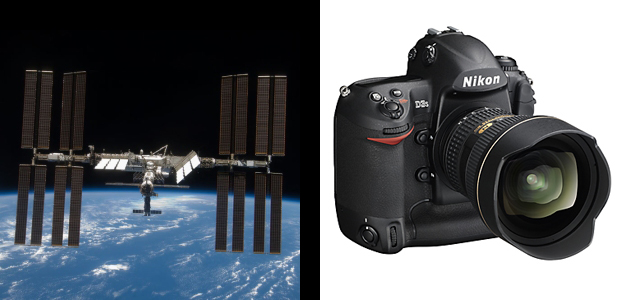Nikon In Space
Whilst we have been sending cameras into space as soon as the first successful rockets lifted off from Cape Canaveral, I thought it pertinent to highlight some of these milestones as the last flight of NASA’s Space Shuttle Program closes the end of an era.
The Saturn V rockets of the Apollo missions were the largest machines ever built. Standing 110 meters high and weighing over 3 million kilos, their five F-1 Rocketdyne engines developed a combined thrust of 7.5 million pounds. On July 26 1971, Apollo 15 lifted of from Cape Canaveral Air Force Station LC-39A. On board was the first Nikon F SLR with its Photomic FTN finder. Very different from the standard model its matte finish, enlarged controls and altered dimensions ensured its reliability was never questioned.
The NASA F model was then further developed in 1973 to incorporate a motor drive and additional modified lenses for use aboard Skylab. This experience also aided Nikon in the development of the F2.
April 12 1981, Space Shuttle Columbia left for the heavens on its maiden flight STS-1. This was the first flight of the Shuttle Program and thus the first use of a re-useable space transportation system. Though more importantly, stowed away in it cargo was the first Nikon F3 to go into space. Although still reasonably modified to meet NASA’s strict standards it was developed concurrently with the consumer model which was released only a few months previous. Two F3 variants were produced for NASA. The F3 small camera as seen above and the F3 big camera which incorporated a special version of the 250 frame bulk film back.
When introduced in 1988 the F4 was revolutionary with its matrix meter, autofocus system and lens compatibility. It was Nikons leap into the future and set the standard for the cameras that followed it. Having learnt a significant amount from the F3, the initial F4’s ordered by NASA differed very little from the production models.
With an ever increasing focus on digital technology, a special and very rare variant of the F4 was developed. This was the F4 ESC (Electronic Stills Camera) and first flew aboard Discovery on STS-48 in 1991. It contained a monochromatic 1MP CCD sensor housed at the film plane and produced images 1024 pixels square. A far cry from today’s DSLR’s but well ahead of its time.
In 1996 the F5 was released to the world. Arguably the last great 35mm camera, its time was limited before it even begun. Fortunately its 1005 segmented 3D colour matrix meter, a blistering 8fps and its incredible ruggedness earn it a place in history. The few F5’s lucky enough to travel into space were virtually the same as those in the hands of many photojournalists and photographers. All that changed was the internal lubricant. It first flew aboard Discovery on STS-103 in 1999.
1999 saw the Nikon D1 introduced and thus the beginning of the digital era. Images from space would never quite be the same. In 2007 NASA ordered a lot of D2X’s and various Nikkor Lenses to be used in flight and aboard the ISS. These were then gradually replaced with the release of the D3, D3X and D3S models. Their full frame sensors and respective features have allowed the capture of incredibly superior images.
*Images used in this article are courtesy of Nikon and NASA.






